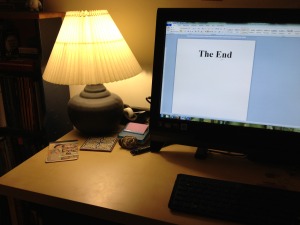 For the first time in months, my desk is clean. Not “clean” in the sense of “dusted,” mind you – let’s not get crazy here. But I’ve put away all the papers I used as reference material for writing my urban fantasy series: the pocket calendar; the Wikipedia printouts (some more accurate than others); the rough outline that I followed, more or less, for the last book; and so on. It’s all back in the file folder that I labeled “Notes for Book 5” back before I had a working title for book 5 and never bothered to change, even after I decided the book would be called Annealed.
For the first time in months, my desk is clean. Not “clean” in the sense of “dusted,” mind you – let’s not get crazy here. But I’ve put away all the papers I used as reference material for writing my urban fantasy series: the pocket calendar; the Wikipedia printouts (some more accurate than others); the rough outline that I followed, more or less, for the last book; and so on. It’s all back in the file folder that I labeled “Notes for Book 5” back before I had a working title for book 5 and never bothered to change, even after I decided the book would be called Annealed.
It’s a curious feeling, to be done writing a series of novels. My original goal was to write an urban fantasy novel – just one! But then I thought, why not make it a series? And if I structured the series on the concept of a Native American medicine wheel, I would have five books: one for each cardinal direction, and one for the heart of the wheel. So that’s what I decided to do.
And now I’m done. Continue reading “The Unbearable Lightness of Being Done”

 This week, we’re beginning a new feature called LynneQuisition. Once a month or so, I’ll be grilling – er, asking questions of – some of the big names in our nascent industry.
This week, we’re beginning a new feature called LynneQuisition. Once a month or so, I’ll be grilling – er, asking questions of – some of the big names in our nascent industry. I admit it: when I ran across this article in Salon, I giggled a little at the title: “
I admit it: when I ran across this article in Salon, I giggled a little at the title: “ A discussion started here Tuesday on
A discussion started here Tuesday on